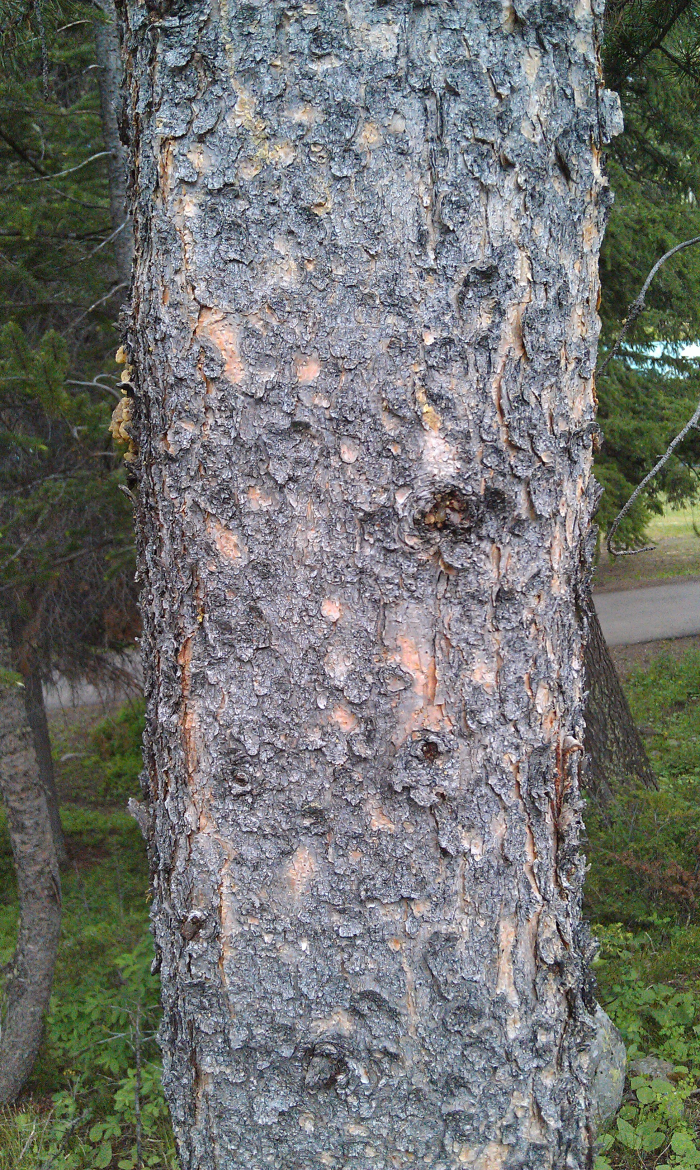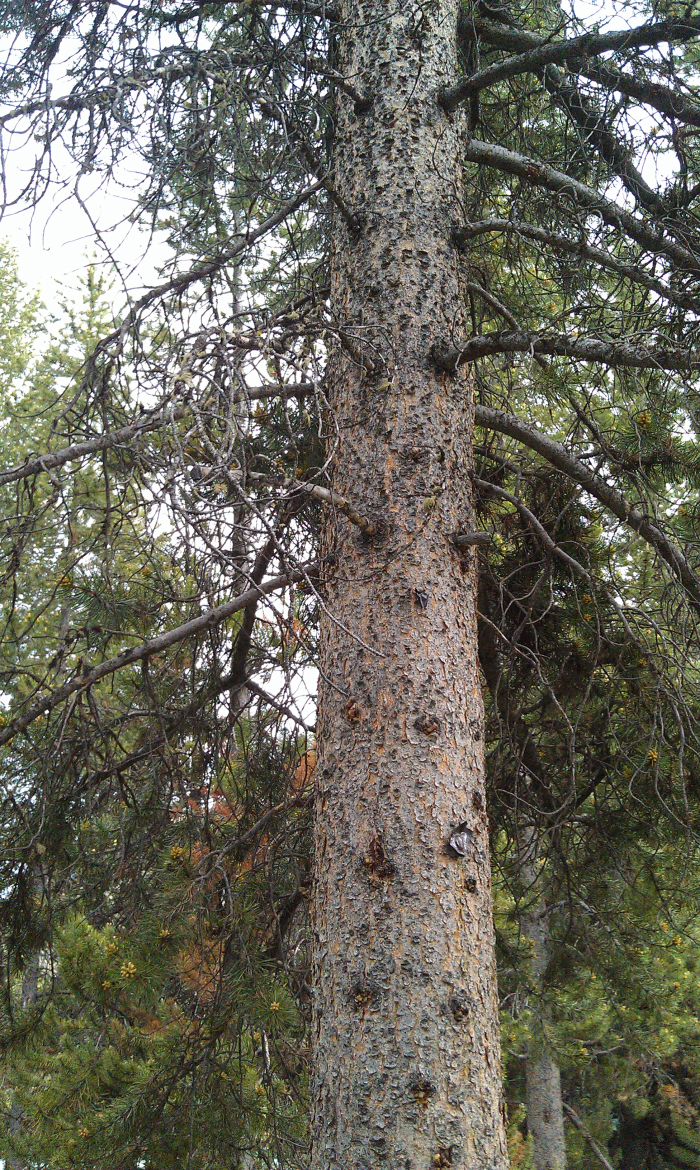Whitebark Pine and the Pine Bark Beetle

by Sidd Mukherjee
June 2017
Pine bark beetle is killing east Yellowstone and spreading, huge swaths dying. Looks like fall, except pine don't
change color in fall and it ain't fall. I hear the wood gets color too, but of course, no logging in Yellowstone ...
\West Yellowstone is better, but i saw it occasionally as far west as Gallatin. And as far north as three forks,
Montana where the jefferson, madison and galltin come together to make the Missouri. Nothing is replacing as a
succession species that i saw. That whole area is monoculture pine, too much for the beetle to eat, and winters not
cold enuf to kill them. One of the people i talked to is trying to plant spruce, but it's hard. Pheromone packets help
a little. Saw it as far east as nebraska, but more varied trees there.
Excerpts from "Beetle Devastates Yellowstone Whitebark Pine Forests"
Jesse A. Logan and William W. MacFarlane
March 2010
The mountain pine beetle is killing pine trees in many areas of North America. The beetle's effects are particularly devastating in the Greater Yellowstone Ecosystem (GYE). Yellowstone National Park looms large in the history of conservation not only in the history of the United States but of the entire world. As the world's first national park, its example has inspired the creation of other parks and natural reserves worldwide; and within the United States, it has played an important role in the creation of the National Forest System.
The mountain pine beetle is a native insect that most likely moved north along with its host pines as the trees colonized the Rocky Mountains. The mountain pine beetle is unique; it belongs to the relatively small group of aggressive bark beetles that must kill their host to reproduce successfully. To do so, the bark beetles make a hole in the tree bark, all the way to the phloem layer (the tissue that carries nutrients to the various parts of the tree) the part they like to eat. They also lay their eggs in this location. Special chemicals are released by the first beetle invaders, and these attract more and more beetles.
The trees try to block the entry of beetles by increasing their own production of resin; however, the beetles are resilient and introduce blue-stain fungi that helps to overcome tree defenses and also provides an important food for developing larvae. Eventually, the phloem layer is too injured to deliver food and water to the tree, so the trees die from the inside out. Mountain pine beetles may also seek to inhabit already damaged trees.
 Effects of global warming
Effects of global warming
The role of climate as a regulating mechanism for the distribution of mountain pine beetles in northern and high-elevation areas was recognized by scientists early on.17,18 Their early findings indicated that seasonal weather of the high mountains imposed two key constraints that served to protect whitebark pine from mountain pine beetles:
- First, historical winter temperatures in whitebark pine habitats were frequently cold enough to kill all mountain pine beetle life stages everywhere but in the most protected sites, i.e., in the tree bole (trunk) beneath the insolating snow cover.
- Second, summer temperatures typically did not provide enough hotter temperatures to complete an entire life cycle in one year. Mountain pine beetles are univoltine, that is, they have one brood a year.
This combination of cold temperature, winter mortality, and cool summer temperatures served to keep mountain pine beetle populations in check. The simultaneous occurrence of conditions necessary to change this historical pattern occurred only infrequently in high-elevation whitebark pine forests.3 With the advent of a warming climate, however, winter temperatures have become mild enough to allow substantial overwinter survival of all bark beetle life stages; and there is sufficient summer thermal energy to complete an entire life cycle in one year.
With the onset of anthropocentric global warming in recent decades, the ecological relationship between mountain pine beetle and whitebark pine has undergone a fundamental shift. The potential for climate change to intensify mountain pine beetle activity in whitebark pine was first recognized in theoretical modeling studies.19,20 These studies suggested that increased mountain pine beetle activity in whitebark pine would be a good "canary in the coal mine" indicator for the ecological impacts of climate change. Unfortunately, subsequent events have played out much along the lines of these early model predictions, with two important differences: the anticipated impacts occurred earlier than predicted; and the spatial extent and intensity of mortality was much greater than anyone could have projected. Although the models accurately predicted the qualitative impacts of a warming climate, the failure to predict the speed and intensity of mortality has resulted from the vulnerability of whitebark pine to mountain pine beetle attack. Apparently, the vulnerability of this species of pine to attacking beetles is much greater than that of the lodgepole pine.
The combination of chronic warm weather and vulnerability to attacking beetles has produced a worst-case scenario. We have consistently observed large numbers of successfully attacked trees in late spring/early summer.21 Apparently, re-emerging beetle parent adults from the previous summer, perhaps augmented by an early phase emergence of newly emerging adults, are responsible for this mortality.22 Winters are becoming mild enough that even adult beetles, a freeze-intolerant stage, are surviving.23 These surviving beetles, at even relatively low densities, have been able to attack new whitebark pine trees successfully. We have observed that strip attacks, in which only a portion of the tree's phloem tissue is killed, are more commonly observed than in lodgepole pines.
Broods produced by re-emerged adults may experience enough thermal energy to complete the life cycle within the same year of attack.24 Even if this early brood does not reach the adult stage, all life stages -- even those previously susceptible to winter mortality -- are surviving. The result is a bipeak emergence of early, re-emerged beetles, and a later traditionally timed emergence. The combination of a warming climate and vulnerability to attacking beetles has resulted in a shift from non-overlapping, semivoltine (life cycle requiring two years to complete) generations to overlapping, univoltine generations that also have a greater potential to reproduce.
 Effects of global warming
Effects of global warming